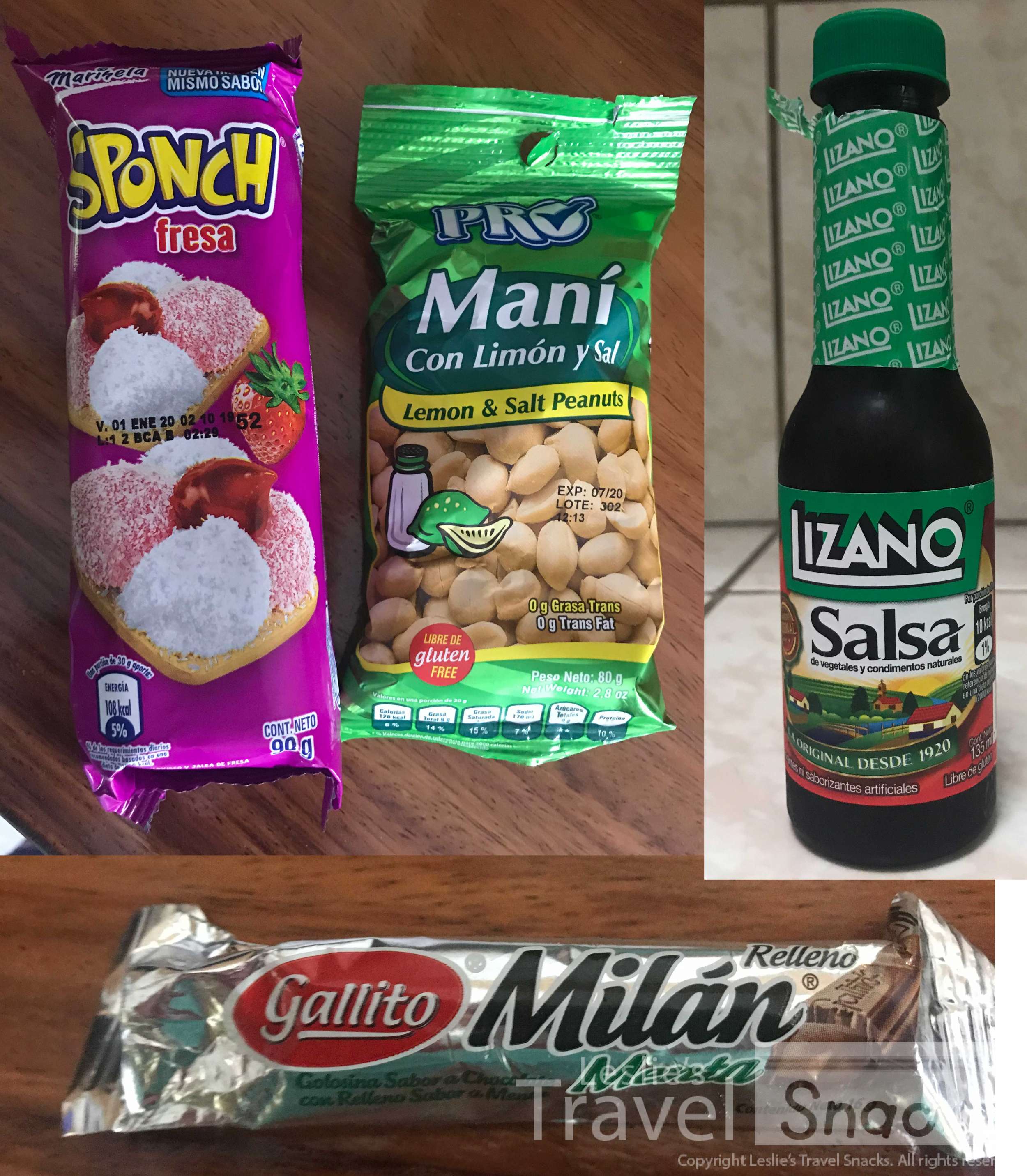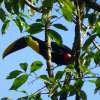Food
A local eatery is called a "soda" and is a good budget-friendly option.Bocas are snacks; like an appetizer but smaller. Sometimes they are free at bars during certain times or usually cost from $1 - $3.
A typical breakfast consists of gallo pinto, a mixture of rice and black beans, fried plantains, eggs, tortillas and a chunk of local crumbly cheese.
A typical lunch / dinner plate is called a casado and consists of rice and/or beans, salad, tortillas, fried plantains, and chicken or something meaty.
Salsa Lizano is ubiquitous. It's a brown sauce that goes on just about everything. And you'll want it. Costa Rican food is known for being rather bland.
Rice & beans, rice & beans, rice & beans.
Costa Ricans call salsa fresca (pico de gallo) chimichurri. So instead of asking for salsa, ask for chimichurri. Or if you see it on a menu, don't expect a typical Argentinian parsley chimichurri.
You can get a fresh cold pipa (PEE-pah - young coconut) to drink from street vendors for $1.
You can drink the tap water!
Costa RIcan coffee is among the best in the world. 1820 brand is the most popular coffee sold in the grocery stores, but there are tons of growers throughout the country.
My favorites snacks are:
• Maní con limón (peanuts with lime) - it's a very fake tart lime but I still like it.
• Sponch cookies - OMG they are so awful but I love them. Think marshmallow snowball atop a butter cookie.
• Gallito Milán Menta chocolatesThere is a lot of gringo food in the grocery stores; peanut butter, cereal, cheese. All at high prices of course. Sunscreen is super pricey - bring your own.
When dining, there's a government mandated 10% service fee + 13% tax + up to 5% credit card fee. If you are at a bar (not a table), these fees are usually waived.
Cacique (or Cuatro Plumes) is the local brand of guaro, a sugarcane liquor. You'll find it everywhere. You can shoot it, have a chili guaro shot, or use it like vodka. See Those Ticos Can (and Do) Drink!
Beer - Imperial is THE Costa Rican beer. Pilsen is a distant second. A beer in a bar will cost you around $2 - $2.50 and around $1.50 in the market (which I find surprisingly high for a local beer in a market).
What would normally be sacrilegious, becomes the norm. You drink your beer over ice, and keep your red wine in the fridge!
It's actually legal to drink & drive, but not to be drunk while driving. Pair that with their less than timid driving style ....
Lingo
Pura vida - most people know this one. It's so very Costa Rican. Everyone says it, and it has many uses. It's like "cool", "chill out", "no problem", "all good", "ahh what a great life", you get the idea.Chao - Just like French ciao. This is used with the side kiss just like the Parisians do, but more often for goodbye rather than hello. And of course it's spelled the Spanish way.
Zarpe - This is a good one. It means last drink, but it's never really one last drink. It's probably many. So after a night of drinking, say "let's go get our zarpe" and you'll elicit a smile for sure.
Tico - They're not called Costa Ricans, the locals are called ticos. A woman is a tica, a man is a tico.
Mae - You might hear a local throw this into almost every sentence. It's like the word "dude."
Tuanis - Cool. As in awesome, not chilly. ;)
Pelo de gato - particularly in the cloud forests like Monteverde, you will often find yourself in a fine mist. It's like you are IN the cloud. It's not rain, less than a drizzle. It's called pelo de gato (cat's hair) because it's so light.
Transportation
I'm not even sure if true public buses exist. It seems to be all private bus lines running different routes around the country. Each having it's own region they service. For instance Transgolfo runs between Paso Canoas and Golfito, TQP (Transportes Quepos Puntarenas) (the route it runs), etc.Tracopa bus line is the main line between San Jose and the southern Pacific coastal regions of the country. Their comfy coach buses are bright pink, green, or orange.
Technology is here! You can now book your Tracopa tickets ahead of time on the Passer app! Woohoo!
Long haul buses will stop along the way at a large cafeteria for 15 - 25 minute bathroom and food breaks. Uvita is a main stop along the Costanera.
Faced with the bus route choice of Costanera vs. Cerro de la muerte, choose the Costanera. Cerro de la muerte translates to Death Hill and it's slow, steep, and winding.
You can expect food vendors to board the bus along the way selling cold drinks, green papaya w/ limon y sal (lime and salt), and friend plantain strips that taste like oil.
Centro Coasting website is a great place to get real information on routes between point A and B in Costa Rica (and other countries in Central America). Sometimes it's just a photo of the schedule posted at a bus stations, but that's the most reliable information you're going to get.
There are official taxis. They are red.
Many tourists rent cars and drive in Costa Rica. Count on it taking much longer to get from point A to point B than you would expect. Most roads are narrow 2-lane potholed disasters with everything from stopped cars, lounging dogs, bicyclists, farming and semi-trucks, and people walking in the road to watch out for! Oh, and the locals drive like a bat out of hell and like to pass on blind corners.
It is customary when driving, to give a nice little beep of your horn when passing someone.
When renting a car, bring a letter from your credit card company stating that they cover the rental car insurance. If you do not have an actual letter, you will be the mercy of the rental company and will pay a bundle for their insurance.
Count on it taking much longer than you expect to drive anywhere in Costa Rica. If it looks like 2 hours on the map, it will probably be more like 4. The roads are narrow and winding and you might experience everything from potholes, to cows in the road, people stopped in the middle of the road talking, a dog in the road, a palm oil truck, a narrow hidden single-lane bridge, or even a small flood. Oh, and watch out for those Ticos overtaking other vehicles on blind corners!
Nature
There really is a lot of wildlife, not just on advertisements. I have personally seen iguanas, howler monkeys, capuchin monkeys, coatimundi, agouti, scarlet macaws, sloths, toucans, snakes, and a whole host of other tropical birds including parrots and parakeets. Thankfully I have not seen any boa constrictors!Rainbows, yes, but also MOONbows! The conditions have to be just right so you'll have to be pretty lucky. A friend of mine has spent most of his life here and has only seen 3 of them. But 3! They do exist. It makes scientific sense, I've just never thought of it before.Even though it's such a heavily touristed country, it's green and lush and very 'naturey'.
In parts of the country you'll find strangler fig trees. These hemiepiphyte plants actually start growing as a seed up in the canopy. Their roots grow down to the ground, creating a lattice-work around a large host tree, eventually killing the tree leaving the fig hollow inside. You can actually climb up inside of these trees and look out of the many openings.
The country is approximately the size of West Virginia in the USA or Denmark in Europe.
Costa Rica has taken conservation seriously since the 80's even though it wasn't very popular then. It's rainforest conservation is better than any other country.
Costa Rica contains an estimated 5% of the world’s biodiversity and 12 different climatic zones / ecosystems including tropical rainforests, deciduous forests, Atlantic and Pacific coastline, cloud forests, and mangrove forests.
It will be hot and humid at the beach, and get cold up in the mountains, especially when the awesome soul-cleansing winds blow.
Everything Else
Oh yeah there are a lot of expats. It's like they have taken Costa Rica as their own personal space and in some areas they keep separate from the locals. There are housing developments and entire towns where there is a distinct separation between the resident gringos and the locals.US dollars are just as widely used in some areas as colones. Even some ATM machines dispense dollars! The big tourist activities and even shuttles are priced in dollars and you're likely to get a worse deal if you try to pay for those things in colones (bad exchange rate in their favor).
Banco de Costa Rica (BCR) doesn't charge ATM fees!
Some ATMs have a low transaction limit, but that's not the daily limit. You can withdraw in more than one transaction to get more money.
It's not a cheap country. The prices are now based on what the tourists and expats will pay rather than what the locals pay.
It's a very clean country with almost no litter.
There are a lot of great surf spots along the Pacific coast.
Tamarindo, because of it's popularity with tourists, is sometimes called Miami Beach. However, it's still really quite small!
Want to drop a ton of dough on some unique lodging? Costaverde turned a 727 airplane into a luxury rental! This is not the only airplane you can stay in. There are some in Sweden, Mexico, and New Zealand to name a few.
The close proximity to the Colombian drug trade is apparent, particularly in the South. It's mainly just a way some of the locals make a living but it also brings more petty crime.
The police usually drive around with their lights on, so don't be alarmed unless their siren is on.
Tico time - think island time. Things run at a bit slower pace. Told to be ready at 2:00? Plan on 2:15.
Be gentle with a Tico's car seats and doors. It's a thing.
There’s almost no such thing as lawnmowers here (except at a few larger properties). No matter how large the property it will be weed whacked.
As with many Spanish-speaking countries, the hot / cold of faucets might be reversed compared what English-speakers are used to. Although the faucets are manufactured with H (hot) and C (cold) labels, there is no proper translation in Spanish, at least for the C (unless you make the stretch to hielo which means ice). Hot = Caliente, Cold = Frío. When a plumber installs a faucet, they will usually pipe C to the hot water (caliente), and it will usually be on the right.

















